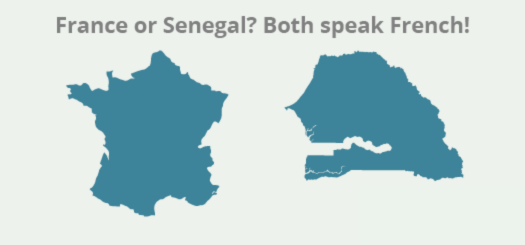I had been working in the field of e-learning for a total of two weeks when I was put on a project team that was translating an English course into several different languages. The excitement over my new job quickly turned to fear since I am a native English speaker and the two years of high school and one semester of French I took in college allowed me to ask where the train station was and possibly order a ham and cheese sandwich. And yet, I was expected to take an e-learning course our client had spent time and money on and somehow get it accurately translated into German, Korean, Japanese, Chinese, and Portuguese all while preserving the integrity of the content.
How would I do this? What was the process of translation workflow? Maybe you’ve felt something similar when you’ve considered translating your e-learning courses into a different language. The good news is I was on a team of people who knew what they were doing and taught me the process.
Translating an e-learning course simply means converting a course from its original language into the “target language.” In addition to ensuring all text and narration is accurate in the target language, the way in which the content is presented with images and tone also has to be culturally correct. This is called e-learning localization. Since that first project, I’ve learned a lot about the translation workflow. And now the process isn’t nearly as daunting as I anticipated. My confidence has grown by following some best practices to ensure our clients’ content reaches an international audience.
Read on to find out how you can benefit from translating your courses. Use these helpful hints and tips to save time and money while creating a successful course.
- Why Choose To Do an E-Learning Translation
- What Is E-Learning Localization?
- What Is the Difference Between E-Learning Localization and Translations?
- E-Learning Translations and Localization: 5 Best Practices
Why Choose To Do an E-Learning Translation?
Companies choose e-learning translations because they need to train team members who will learn more effectively in the target language. Rather than send someone to present the training to employees with an actual translator, it’s much easier to translate the English course into that target language. This e-learning course can then be completed by all employees.
If your company is thinking about translation, getting started might seem intimidating if you aren’t fluent in anything except your native language. You don’t have to feel this way! A company seeking translation doesn’t have to speak the target language. Translation companies, such as our favorite partner Lingualinx, have you covered. When you contract with them, you’re contracting with professional linguists who make sure the text and narration are correctly translated. Your job is to convert the e-learning course using the translated content.
Still unsure about the nuts and bolts of e-learning translation? The process of creating these courses is quite simple if you follow these steps:
- Export text and narration from your authoring tool.
- Send the export to a translation company for accurate text and narration in the target language.
- Import translated audio, text, and graphics back into the course.
- Sync the audio with the text and images that appear onscreen.
- Complete a rigorous QA process.
- Send the translated course to a native speaker for review, if possible.
What Are the Benefits of E-Learning Translations?
The world seems to become smaller all the time. More and more companies have employees working all over the world. Items are being shipped from one side of the globe to the other every day. For example, machinery manufactured in one country is sold worldwide and there’s a need for training on anything from how to sell the product, to how to operate it. One course may need to be translated into thirteen languages before you know it. By making sure your e-learning is translated and ready, you:
- Ensure team members, students, and clients around the globe learn your content.
- Increase the accuracy of your content without relying on an in-person instructor or translator.
- Gain respect in your industry by demonstrating you are committed to training employees in an inclusive way.
What Is E-Learning Localization?
Making sure your translated e-learning content is culturally relevant and appropriate is e-learning localization. Your audience needs to be able to understand the connotations in the content. A course filled with colloquial language or slang specific to the original language could limit the users’ understanding once the content is translated.
What Is the Importance of E-Learning Content Localization?
- Empowering learners across cultures to see themselves in the content
- Ensuring you’re providing culturally-appropriate content so users are not offended or confused
- Improving learning engagement across locations so it is easily understood and comprehended
- And more!
What Is the Difference Between E-Learning Localization and Translations?
How does translation differ from e-learning localization? While translating is literally making sure the content is in the target language, localization makes sure that the course is adapted to accurately represent the target culture. This impacts things like the style of narration, images, abbreviations, and language. You want to present the information from your course with the correct interpretation—not just language—for different cultural settings.

Something as simple as the statement, “He aced the test,” could have a very different meaning to someone not from North America. Even color choices or symbols could create confusion for a user. Knowing the target culture is as important as knowing the target language.
E-Learning Translations and Localization: 5 Best Practices
1. Clearly Identify Your Target Audience by Planning for Translation at the Start of Original Course Development
Be sure you really know who your audience is. You’re probably thinking, “Of course I know who my target audience is. It’s being translated into ________.” (Insert your language of choice here.) What you need to think about goes beyond language choice.

There may be one language choice but different cultural preferences between a few different groups where the course will be used. Let’s say you’re translating a course into French. Where exactly will you be using this course? Is the course going to be used primarily in an African country where French is spoken? Will it be used in France where the culture greatly differs? Are you translating it to both? This is where cultural localization comes to the forefront. You may need images that are specific to each culture if the course will be used in two different locations in the world. Another consideration is dialect for the area where the course will be used. Users need to be able to see and hear themselves in the course for it to be relatable.
2. Do a Comprehensive Review of Translated Text Early In The Process
One of the first steps in the process is translating the in-course text and narration. This is done by sending the English export to the translation company. Once it is returned to you, you’ll need to make sure that industry terms have been translated with the same meaning as what the words meant in the original. It’s important to do this as soon as possible so the narration can be recorded accurately.
At Artisan Learning, we suggest our clients have one person lined up to do this task so it can be completed quickly and efficiently. Sometimes too many people reviewing can create bottlenecks (a word you’d want to avoid in a translated course). You might be wondering what happens if you don’t have a native speaker of the target language available to review this text. Never fear! Most translation companies can provide this service. They can find a native speaker to do this specialized review.
3. Avoid Using Text Embedded in Images

Using embedded text in the graphics or images of your e-learning course may seem like a great idea when you’re creating the original course. When you need to translate the course though, you could be presented with issues. This text can be translated, but it makes the process inconvenient. It could cost you time and extra money to get this text into the target language. There are also issues when the source image can’t be located. Without this, the text cannot be easily fixed. It requires the whole image to be recreated.
4. Be Mindful of Character Audio Within Original Language Course
Everyone wants engaging e-learning. One way to captivate your learners is the way you incorporate narration. Many times courses have the main narrator for the course and then include character audio to add interest. When courses are translated, these additional characters will cost you as you now need more audio talent to create the translated course. This may be within your budget for one additional language, but can quickly add up as the number of languages increases.
5. Make a Plan for Reviewing Completed Translated Courses
Once your course is put back together in the target language, you’re almost done! However, this is where your review process is very important. A helpful hint is to take the original course and compare the translated course to it screen by screen. Doing this review with both courses open ensures that things like text, graphics, and images are in the same place and appear on the screen at the same time. Even if you don’t speak the target language, as long as you can follow along to the sound of the words, you can compare it with the transcript making sure all of the text has been included.

If you’re lucky, you have a native speaker to review the entire course. This person will not only make sure that the course in the target language looks the same, but also be sure that the actual text was translated correctly. Not everyone has a fluent Chinese or Italian speaker at their fingertips though. Maybe your course has text in characters like Korean or Japanese. What do you do in situations like these? This is where working with a great translation company comes in handy. The translation company you’ve chosen can do a variety of tasks to ensure your course is ready to be presented to learners in the target language. They can review the course and offer feedback on what components need to be changed. When they finish, you make the appropriate changes, send it back to the translation company for approval, and end up with a course that you can be confident is ready for your learners.
Hesitant about translation?
Not convinced that you can do your own e-learning translation and localization yet? Still feeling hesitant about the translation workflow? If you’ve been persuaded that e-learning translation is the direction your company should go, yet you’re not sure you can embark on this experience by yourself, you can use an e-learning company that gives you a cost-effective option to do all of the steps. At Artisan Learning, we have many years of experience in the field of e-learning translation and would be happy to help in any way we can. Contact us about translation and localization services now.
Additional Resources:






